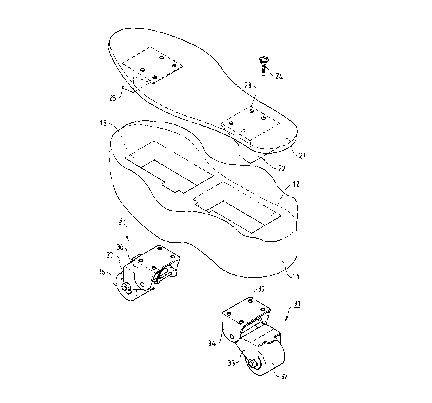Some of the information on this Web page has been provided by external sources. The Government of Canada is not responsible for the accuracy, reliability or currency of the information supplied by external sources. Users wishing to rely upon this information should consult directly with the source of the information. Content provided by external sources is not subject to official languages, privacy and accessibility requirements.
Any discrepancies in the text and image of the Claims and Abstract are due to differing posting times. Text of the Claims and Abstract are posted:
| (12) Patent Application: | (11) CA 2258980 |
|---|---|
| (54) English Title: | BASE STRUCTURE FOR ROLLER SKATES |
| (54) French Title: | STRUCTURE DE BASE POUR PATINS A ROULETTES |
| Status: | Deemed Abandoned and Beyond the Period of Reinstatement - Pending Response to Notice of Disregarded Communication |
| (51) International Patent Classification (IPC): |
|
|---|---|
| (72) Inventors : |
|
| (73) Owners : |
|
| (71) Applicants : |
|
| (74) Agent: | ROBIC AGENCE PI S.E.C./ROBIC IP AGENCY LP |
| (74) Associate agent: | |
| (45) Issued: | |
| (22) Filed Date: | 1999-01-27 |
| (41) Open to Public Inspection: | 2000-07-27 |
| Examination requested: | 1999-01-27 |
| Availability of licence: | N/A |
| Dedicated to the Public: | N/A |
| (25) Language of filing: | English |
| Patent Cooperation Treaty (PCT): | No |
|---|
| (30) Application Priority Data: | None |
|---|
A base structure for a roller skate includes a base having at
least two compartments, a bottom plate secured to the base, and a
number of wheel assemblies each of which is mounted in an
associated compartment. The bottom plate includes a number of
blocks formed on the underside thereof, each block being
received in an associated compartment. Each wheel assembly
includes a pivotal seat having a first end secured to the underside
of the bottom plate, a wheel seat having a first end pivotally
connected to a second end of the pivotal seat, and a wheel
rotatably mounted to a second end of the wheel seat. Each wheel
seat may be pivoted to a storage position in the associated
compartment when not in use. When skating is required, each
wheel seat is pivoted to an operative position, in which each
wheel seat bears against an underside of an associated block
while the wheel rotatably attached to each wheel seat extends
beyond the base for skating.
Note: Claims are shown in the official language in which they were submitted.
Note: Descriptions are shown in the official language in which they were submitted.

2024-08-01:As part of the Next Generation Patents (NGP) transition, the Canadian Patents Database (CPD) now contains a more detailed Event History, which replicates the Event Log of our new back-office solution.
Please note that "Inactive:" events refers to events no longer in use in our new back-office solution.
For a clearer understanding of the status of the application/patent presented on this page, the site Disclaimer , as well as the definitions for Patent , Event History , Maintenance Fee and Payment History should be consulted.
| Description | Date |
|---|---|
| Inactive: IPC from MCD | 2006-03-12 |
| Application Not Reinstated by Deadline | 2003-01-27 |
| Time Limit for Reversal Expired | 2003-01-27 |
| Deemed Abandoned - Failure to Respond to Maintenance Fee Notice | 2002-01-28 |
| Application Published (Open to Public Inspection) | 2000-07-27 |
| Inactive: Cover page published | 2000-07-26 |
| Inactive: IPC assigned | 1999-03-03 |
| Inactive: IPC assigned | 1999-03-03 |
| Inactive: First IPC assigned | 1999-03-03 |
| Classification Modified | 1999-03-03 |
| Filing Requirements Determined Compliant | 1999-02-16 |
| Inactive: Filing certificate - RFE (English) | 1999-02-16 |
| Application Received - Regular National | 1999-02-16 |
| All Requirements for Examination Determined Compliant | 1999-01-27 |
| Request for Examination Requirements Determined Compliant | 1999-01-27 |
| Abandonment Date | Reason | Reinstatement Date |
|---|---|---|
| 2002-01-28 |
The last payment was received on 2001-01-05
Note : If the full payment has not been received on or before the date indicated, a further fee may be required which may be one of the following
Please refer to the CIPO Patent Fees web page to see all current fee amounts.
| Fee Type | Anniversary Year | Due Date | Paid Date |
|---|---|---|---|
| Request for examination - small | 1999-01-27 | ||
| Application fee - small | 1999-01-27 | ||
| MF (application, 2nd anniv.) - small | 02 | 2001-01-29 | 2001-01-05 |
Note: Records showing the ownership history in alphabetical order.
| Current Owners on Record |
|---|
| CHUN-CHENG CHANG |
| Past Owners on Record |
|---|
| None |